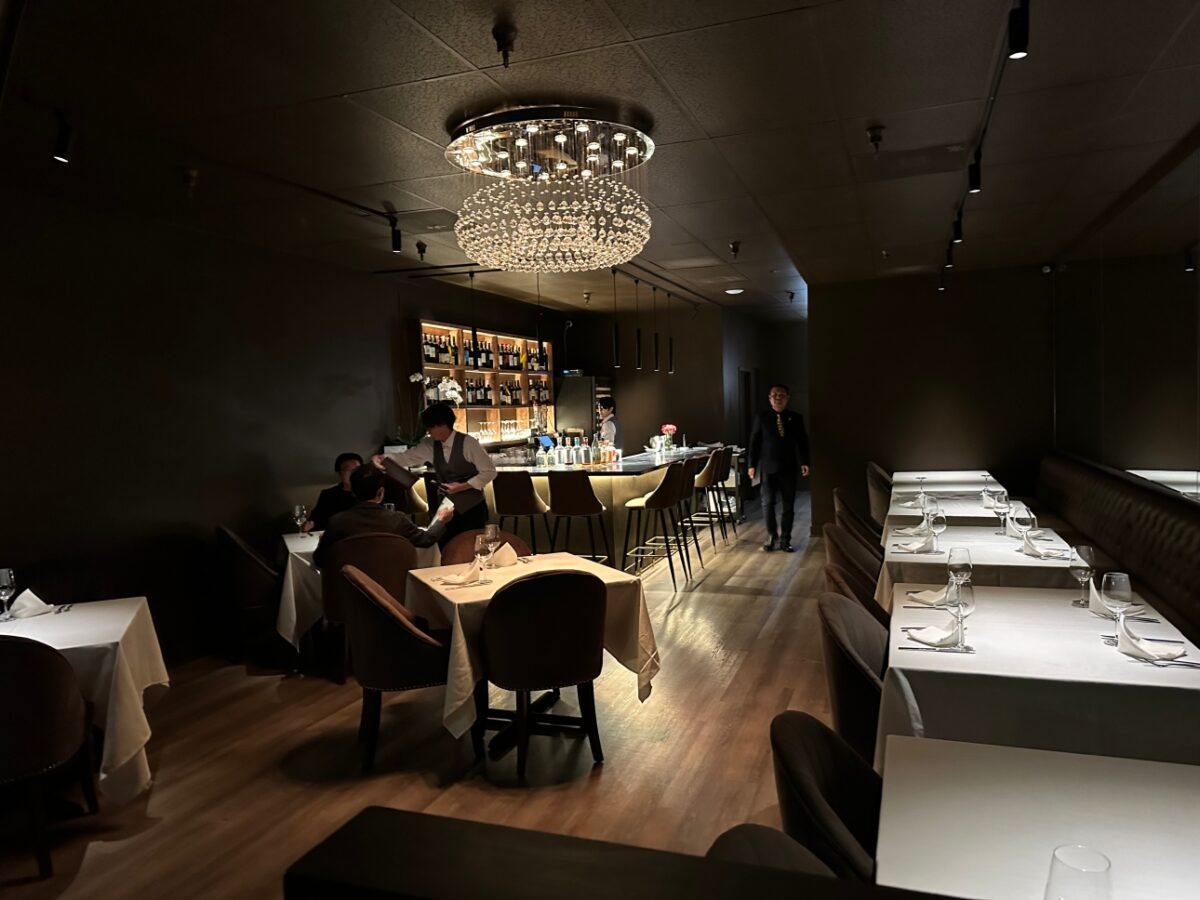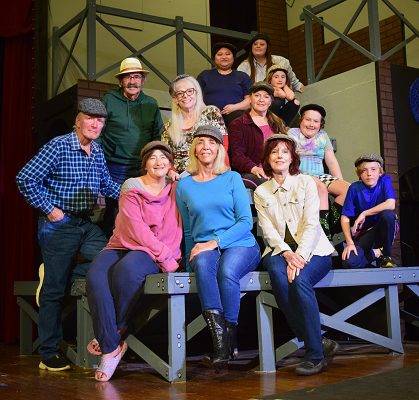People who enjoy lively, loud restaurants sometimes say quiet restaurants are like dining in a library. To some people, that would not sound like a bad thing. We’ve found books we loved, and sometimes people we loved too, amid the shelves of arcane knowledge, witty or serious stories, and the volume in the nonfiction section that told us how to fix a broken vintage toaster. There are several restaurants in LA that have library-themed rooms, including an acclaimed bar whose drinks are all puns on famous books.
When I heard about The Steak Library in Lomita, I wondered if their décor is a riff on this theme. It isn’t, but it’s not an ordinary restaurant environment. The first thing you see as you walk in is a set of refrigerator cases where massive chunks of beef are dry aging, which is beautiful to a connoisseur of meat, but can be disconcerting to those who don’t like reminders that their meal once was a live animal. This is not a restaurant for those persons. This is a place for those who admire the marbling on the Kobe ribeye, compare the color of the cuts from various Japanese prefectures to the American tomahawk steak, and wonder how olive-fed cattle are different from grass-fed.
Once you pass that exhibition of boutique protein, you enter a dramatically lit dining room that evokes mid-century elegance. Starched white tablecloths without a wrinkle contrast with the black walls, and are illuminated by a chandelier that resembles a glowing undersea creature. The gleaming glassware at the bar is arranged with geometric precision. A manager clad in black from head to toe except for his necktie presides over staff wearing black vests over their white shirts. A lot of thought has been put into this environment, and it raises your expectations for the meal.
The menu is brief, six starters, two soups and two salads, and a few seafood appetizers, plus entrees that all justify the restaurant’s name. There are 13 steaks, and that’s it — no token salmon, roasted chicken, or veggie platter for the person who doesn’t eat red meat. Your main course will be beef, and that is that.
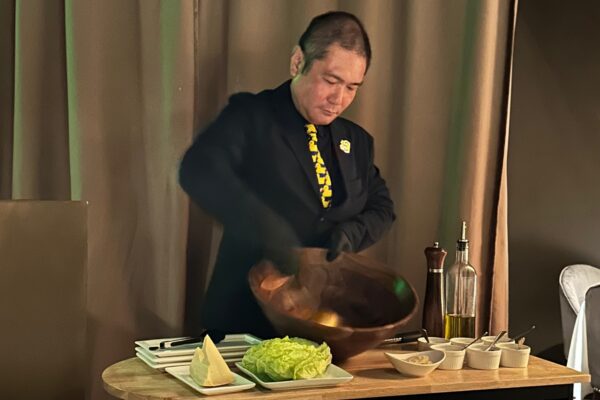
First, though, there are starters that range from faithful steakhouse standards to modern culinary spectacles. In the former category are Caesar salads made tableside, executed with solemn showmanship straight from classic restaurants of the 1930s. The maitre’d, clad in black from head to toe except for a tie and matching handkerchief emblazoned with rubber ducks, wheels out a cart with the lettuce, block of parmesan, oil, and other ingredients of the classic, along with a large wooden bowl. Oil is poured, an egg is cracked, cheese is grated, anchovies and garlic added with great ceremony, and the dressing is poured over the romaine leaves with a flourish and finished with a grind of pepper. The ritual is riveting, and the resulting salad is precisely as it should be, the classic classically executed.
The cotton candy wagyu is a modern dish that is just as theatrical in its own way. It arrives with a fluffy ball of spun sugar, almost entirely obscuring a bowl of mushrooms and sliced wagyu steak in a rich, salty stock. More of that hot stock is poured on the cotton candy, which does a disappearing act – it melts into the stock, showing a raw egg that is lightly poached by the heat of the liquid. When the egg and sugar are mixed into the stock, you get the trinity of sweet, salty, and umami that are at the core of the modern palate. Most modern Japanese restaurants serve something that tastes similar to this, albeit made with sweet sake and much less flair, and it’s delicious on its own merits. Garlic toast arrives at the table as an appetizer, and I was glad I saved a bit to mop up every drop in my bowl.
On the evening we were there, a special of garlic sauteed scallops with truffle sauce was offered.. The scallops were very large but quite tender, and lightly cooked at medium temperature so that the inside was just a bit gelatinous. The truffle oil and herb seasonings were subtle but effective, and under other circumstances I could have happily had a plate of these as the entree.
As previously noted, seafood entrees aren’t a thing here, and after looking longingly at the olive-fed beef and other exotica that are sold by the three-ounce portion, we ordered conventionally aged prime filet mignon, a ribeye, and a dry-aged porterhouse. All beef is aged for at least a short time so that the enzymes in the meat can break it down and make it tender, but the technique affects the flavor. Wet aged beef, which is what you find in most stores, is wrapped in plastic so no moisture escapes, while dry-aged beef is left exposed to cold moving air so that it loses water. This takes more time and concentrates the flavor while reducing the weight, and it’s the reason dry-aged beef is more expensive.
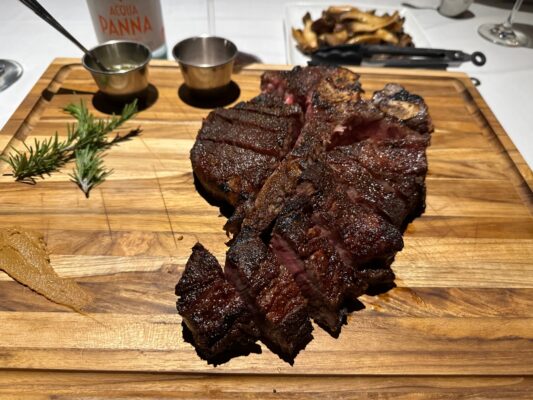
All three steaks were ordered medium-rare, but the difference in flavor and texture were obvious. The filet mignon was a “baseball cut,” not spherical but about the size of that piece of sports equipment, a lump of meat that towered about four inches above the plate. Cooking a piece of meat that thick so that the center is medium rare is an art, and they nailed it. Filet mignon is famously mild and soft, and this could have been cut with a butter knife. It had been seasoned with salt and pepper while cooking and was finished with a bit of soy butter and a sprinkle of parsley, and was one of the best filets I’ve ever had.
I still preferred the ribeye, a fattier cut of meat, because when it comes down to it, fat is flavor. As the steak cooks and that fat infuses the meat, it caramelizes on the exterior and enhances that umami that steak fanatics crave. There was a bit more chew and variety of textures, and at almost any other meal this would have been the star attraction. But at this dinner, there was also that porterhouse, a majestic 40-ounce chunk of cow that arrived pre-sliced on a wooden cutting board. Some of that weight is the bone that goes down the center, and the meat on each side of that bone has a slightly different texture and flavor. If you order those separately, one is New York strip, the other side tenderloin. The strip has a bolder flavor, while the tenderloin is leaner and more delicate. The dry aging process gave both sides a slight creamy funkiness, not as pronounced as lamb but in the same ballpark. Eating this was a lesson in the art of beef, and since it was really a portion for two, the $120 price tag made it a reasonably priced educational experience.
Small portions of house made sauces are available, and we tried the peppercorn, yuzu pepper ponzu, and anchovy butter. Anchovy butter is great on a steak that has been dry-cooked, and superfluous on one that already has the sake butter. But the other two enhanced the flavor of the meats.
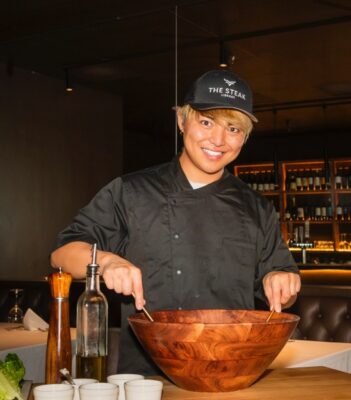
The sides offered are the only weakness at The Steak Library, not because the ones we tried weren’t very good, but because the selection was unbalanced. They offer mashed potatoes, mac and cheese with or without lobster, roasted mushrooms, and grilled asparagus. If you don’t happen to like asparagus, as one of my dining companions didn’t, there are no green vegetable options. A steakhouse classic like creamed spinach or succotash would offer a nice counterpoint to the avalanche of protein. That said, the roasted wild mushrooms were luscious, and the mac and cheese fine if you like a velvety, creamy sauce without the top browned.
The Steak Library’s impressive looking bar stocks only beer, wine, and soju-based cocktails, but their low alcohol drinks are very well made. I was skeptical when I ordered the “Old Man” cocktail, their version of an Old Fashioned, but it was as close to the flavor and body of the real thing as I’ve had from a low alcohol variant. The wine list is curiously short but well-chosen, and as might be expected, strong on reds that pair nicely with steaks. We stuck to the by-the-glass menu and particularly enjoyed the Grignolino from Heitz Cellars, which is best known for their Cabernets. The fruitiness of this grape is often compared to strawberries, and there was some of that freshness with just enough tannins to make it an interesting choice.
Dessert is offered, but we didn’t find the choices interesting and were full from our steaks. Our sybaritic meals ran about $190 per person, and we didn’t choose the most expensive items from either the food or drinks menu. Was it worth it? Peak experiences are rare, and both the ceremonial and culinary experiences of this meal set a standard. I can still remember some meals that I enjoyed two decades ago in detail – not many, just the best. I’m sure this one is going to join that short list.
Note: The same meats that are served at The Steak Library are available in Japanese Yakiniku style at their sister restaurant Tamaen next door.
The Steak Library is at 1937 Pacific Coast Highway in Lomita. Open 5 p.m. – 10 p.m. daily except Tuesday. Parking lot, wheelchair access good. Noise level low. No vegetarian options. (424) 263-5373. SteaksLibrary.com. Pen

